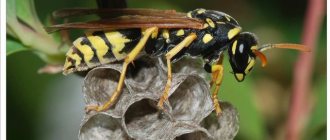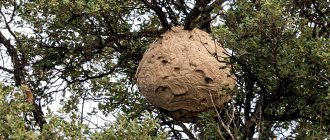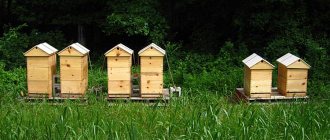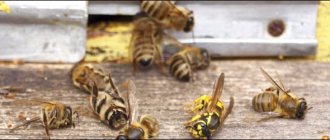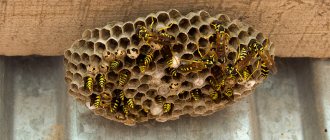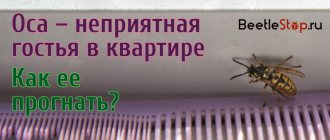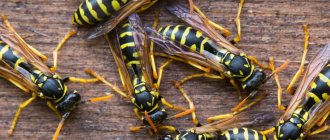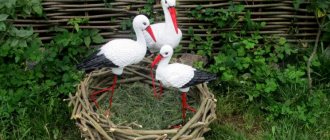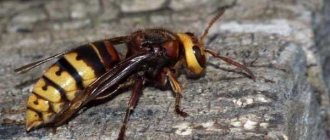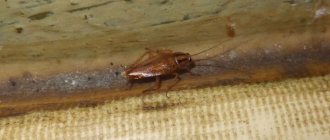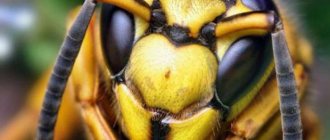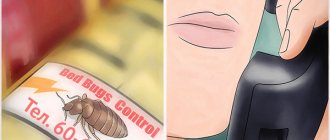How wasps build a nest
To obtain such a thin, durable material for construction, the wasp lands on a wooden surface. A fence, roof, barn wall or any building, wood chips, sawdust or wood will do. The insect releases saliva, which softens the top layer of wood. Then it scrapes off the fibers with its powerful jaws. Having collected a sufficient amount of this peculiar building material, it flies to the place where the future nest will be.
this woody mass is additionally chewed, simultaneously moistened with saliva. The result is not just pieces of wood, but a viscous sticky mass. The insect “spits” it onto the edge of the nest and stretches it. The mass hardens quickly, and a thin, durable partition is obtained. Moreover, it can be as thick as paper or as thick cardboard.
The construction of the house begins from the middle, with individual cells. This part is the strongest, there is a uterus (queen) of wasps with eggs. To build the middle part, it is not paper that is used, but small slivers of wood that are held together with saliva.
Nest construction starts with 1 cell.
New ones are being built nearby.
While there are no worker wasps, the queen builds the nest herself.
Gradually the nest grows
There are more and more new cells.
This is roughly how the construction of a wasp's nest occurs.
The next layers of cells are built up around the middle. They are located horizontally, on several floors. Every 3-6 rows of wasp honeycombs are separated by small corridors. The interesting thing is that all the cells face downwards, in one direction. But wasp honeycombs are not the same: there are cells for larvae, storage rooms, and a room for the queen.
A special feature of the aspen house is that it is constantly being built on, and insects often take material for the outer layers from the middle. Unlike bees, they do not clean their home, but simply leave the polluted cells.
Construction material
Wasps are excellent builders, and they select the best material for their houses - wood. Everything that wasps make nests from (pieces of trees, stumps, wooden elements of various buildings) is pre-treated by the insects with their own saliva.
"Tree house"
After this treatment, the finest wood fibers are easily scraped off using the powerful jaws of the wasp. The collected material is sent to the wasp construction site, where it once again passes through the insect’s jaws and is moistened with a special sticky secretion.
The wasp deftly stretches the resulting mass into a thin plate, having previously attached it to the edge of one of the cells of the nest. It is noteworthy that the thickness of such a wall can vary from almost transparent to quite dense, reminiscent of cardboard in texture.
When does nest construction begin?
Construction of the hive begins in early spring. The young queen chooses a place, creates a base - a small leg, which she attaches in a secluded place. The first cells are set up around it, at first a small number. Then it lays eggs in them. After a month, the workers hatch and actively take on the further construction of the hive. After this, the queen is engaged only in raising offspring.
The number of worker insects in a wasp swarm is growing rapidly, so the hive is also built quickly. If the swarm is large, it can double in size in a few hours. But this depends on the needs of the swarm; sometimes the queen is content with a small size. Construction is progressing in stages.
- After the first worker wasps hatch, they begin to gradually build new cells around the middle, where the queen lays eggs.
- The wasp's home increases in depth and grows to the sides. Gradually takes the shape of a bowl. The hole remains at the bottom.
- Around the end of June, insects begin to build around the second part of the sphere, repeating its shape.
- Gradually, the internal cells are removed, and this material is used to build the outer sphere.
- By the end of summer, construction ends. Young queens fly out and look for a secluded place for wintering.
This device creates a special climate inside. The wasp hive always maintains the same temperature and humidity.
Where do wasps nest?
When the queen is looking for a suitable place for her future home in the spring, she makes sure there is food and building material nearby. Most often, wasp nests can be found in the following places:
- on the branches of trees or bushes;
- in attics;
- under the roof of bathhouses, sheds, garages;
- in the corner of the balcony;
- cracks between bricks, logs;
- under window sills, cornices, drain gutters;
- in a hollow tree or in an old stump;
- abandoned birdhouses or bird nests.
Please note that these insects like to settle close to humans. They are attracted by the smell of food and many dry crevices. Wasps can chew through wooden floors and even cement. But sometimes the uterus does not find a suitable place. Then she can make a house even underground.
From unusual places: an old Chevrolet turned into a giant nest of wasps. With such an anti-theft feature, you don’t even have to close the doors.
What does a wasp's nest look like inside?
The size of a wasp hive may vary, but the shape is always the same. They resemble an egg with a hole at the narrow end. Moreover, they are almost always located so that the exit is directed downward. Sometimes the dwelling is placed horizontally, then the hole is directed to the side. If the queen has made a home in the ground, the exit will look up.
If you're wondering what the inside of a wasp's nest looks like, you can see the photos at the end of the article. Or, you can find the abandoned one and cut it up. But first it is important to make sure that the insects have really left it.
Usually the hive is no larger than a large apple. But some can grow to the size of a ball or even larger. There are giant ones - more than a meter in diameter.
Features of some types
Varieties of paper specimens are black and yellow in color. The nests are round and can be found in the attics of buildings and the walls of various buildings. Nests are made from paper produced by the individuals themselves.
The flower wasp is a very small creature, its size reaches no more than 1 cm. They feed on pollen and nectar of various flowers. The flower wasp builds a nest from sand and clay, holding them together with its saliva.
The largest representative of the family is the hornet. Its length can reach 55 mm. Parasitic wasps include glitterweeds. These bright and shiny individuals are accustomed to living on other bees and butterflies. Sand wasps dig holes in the ground to live in. Road views do the same. The food for the larvae is spiders and insects, paralyzed by the poison from the sting of adults.
This insect belongs to the order Hymenoptera
The German wasp is interesting because its females and males differ from each other quite noticeably. Males are large in size, small females have no wings at all and look more like ants. These ants are often called velvet ants because their bodies are covered with fluff.
Scolias look very beautiful. These are insects up to 10 cm long. They look more like butterflies.
Black wasp Typhia. They often settle on the body of the cockchafer. Sometimes they burrow into the ground in search of beetle larvae.
How many wasps in one hive
Wasp hives come in small and large sizes and can accommodate different numbers of insects. Sometimes the queen wasp makes a small nest, about the size of an apple. A small swarm of wasps grows slowly, so there are few insects. But some nests can be home to hundreds of thousands of wasps. The largest hives can contain up to a million individuals.
The swarm grows mainly due to worker wasps. There are most of them, they concentrate around the uterus and continue construction. There is a strict matriarchy in the wasp colony. There are much fewer males than females; males do not have a stinger, but have very long antennae.
As for giant colonies, here's another video for you: a huge nest in a barn
Correction: in the video they destroy a nest of hornets, but they are related to wasps. To destroy such large colonies, it is better to involve specialists and do without amateur efforts.
How long do wasps live in a nest?
The life of a wasp swarm in the hive continues all summer. Starting from spring, when the queen begins construction, and almost until the end of summer, the growth of the family continues. By July the number of individuals increases. By the beginning of autumn, the activity of insects decreases, they weaken and die more and more often. By the onset of cold weather, several young queens remain and find a place to winter.
To get a more complete picture, I recommend reading the article about wintering wasps
This order of life of a wasp swarm continues constantly. In autumn, the wasp's nest becomes empty. And the next year the uterus begins building a new one.
Precautions and Recommendations
Whatever decision you choose regarding how to remove a wasp nest, you should remember precautions. If the question is how to remove these pests in the spring, when the colony is still small and consists of several individuals, this will be easier to do than in the summer, when their colony will number several thousand
In the fall, when cold weather sets in, these insects leave their home; you can safely throw it out - it will be empty
Handle dead wasps with care too. Their sting, even after death, remains capable of piercing human skin
Wear protective clothing that is not tight to the body, protect the face, skin of the hands, feet - then proceed to action. Treat the location of the cocoon with poison - this is a warning against the return of surviving wasps.
Wasp nests in the ground
This article would not be complete without earth wasps. Yes, there are such people. They settle in old mole holes or dig their own. Fortunately, they have a talent for this. Finding an underground nest is more difficult than usual, but inside it is exactly the same - paper and cells for food or larvae. There is no honey there either. But there is this video about underground flyers:
God forbid you step on something like this. You will run very fast.
There is a separate article about wasp honey, but looking ahead, I will say right away that they are lousy honey makers. More precisely, none at all.
How to find a wasp's nest
Wasps can be useful for the garden and garden, as they destroy small insect pests and pollinate plants. Therefore, if their proximity does not cause disturbance, it is better not to touch them (the case is very rare, almost unreal). But these insects can be very aggressive, often attacking a person for no apparent reason.
If you notice a lot of wasps near your house, it is better to look for their habitat and destroy them. This is especially important if the family has small children or allergies.
They are attracted by the smells of food, but these insects do not fly further than 100 meters from the nest. Therefore, it must be found. To do this, inspect all secluded places, especially under the roof, eaves, and window sills. They like to settle in places where people rarely visit, where there are a lot of things. You need to look for them in sheds and garages.
If you can’t figure out where they live, you can try to lure them out. Workers carry food for the larvae. Therefore, you can put a strong-smelling bait in a visible place. Something sweet or a piece of smoked fish is best. You need to watch it: insects will fly from the bait to the nest. The paths of their movement will help to calculate the location of the hive. These comrades managed to find and destroy the hive. Quite an interesting video in which nomadic marabunta ants found and are destroying a wasp hive. This whole swinging rope is interlocking ants. This is how the bridge turned out. If you look closely, you will see how they drag larvae and eggs from the nest. The wasps themselves, as I understand it, have already been driven away or destroyed.
Well, to conclude our story, a few photographs of huge wasp nests.
Repellents
House bugs are afraid of certain aromas; they detect them using neurons located on the hairs. Repellent plants include the following herbs:
- Sagebrush. This plant is the most effective and efficient. Wormwood is a popular way to help repel bedbugs; the herb is inexpensive and is quite easy to use. You can pick the plant yourself or buy it at the pharmacy. If the scaring period occurs in the summer, it is better to pick fresh wormwood. Bed bugs do not like the smell of this plant, so it is necessary to spread the grass in different places: under baseboards, beds, mattresses, rugs, in cabinets, bedside tables. It definitely won’t help get rid of bedbugs, although it will scare them away for a while. But these bloodsuckers will still leave offspring. The plant has no effect on the eggs, and over time it loses its effectiveness. But it is a good preventive measure and will help people living in a house that has these bloodsuckers to alleviate their suffering for a certain period of time. If there are no bed bugs in the apartment, but the neighbors have them, it is recommended to place wormwood at the threshold, in the ventilation grilles. This way, the neighbor’s problem will not be “transferred” to you. Before laying out the grass in the house, you need to do a wet cleaning and wash the bed.
- Tansy. When asked what bed bugs are afraid of, you can find many rave reviews regarding this herb. Some may be lucky enough to get rid of these insects for a while, but not for long. These cute yellow flowers cannot solve the problem globally. Yes, insects are afraid of their smell and will not cause unpleasant moments to the owners of the house for some time. Insects are afraid of this grass, just like wormwood. It is recommended to place it under mattresses, beds, sofas, and baseboards. You can use tansy decoction. To do this, boil it in water and, after cooling, spray it throughout the apartment. The decoction and tansy herb have no effect on eggs, but insects are afraid of it.
- Air. The rather pungent smell of calamus can repel house bugs. You can buy it at the pharmacy, it is sold in powder form. You should scatter the powder under mattresses, beds, baseboards, and in the corners of rooms. Calamus is completely safe for people and animals. It is added to infusions and decoctions.
- Chamomile. Previously, the drug pyrethrum was made on its basis. Nowadays it is practically not on sale, so an alternative is pharmaceutical medicinal chamomile. Bed bugs are very afraid of its smell. This plant is completely safe and has a calming effect on people. It is recommended to use chamomile essential oil. You should leave a few drops on the night light.
- Bay leaf. A plant that is completely safe for the health of households and is often used in cooking. But bed bugs cannot stand the smell. Leaves can be laid out in unlimited quantities. Also, infusions are prepared based on them, added to water and washed floors.
Herbs can provide effective help if there are a small number of insects in the house. Despite the fact that the herbs can smell strongly, insects are able to overcome their fear, as it is overcome by hunger.
Repeller
You can also try purchasing a bedbug repeller. The manufacturer gives 100% effectiveness. It is safe for people and pets. Judging by the reviews available on the Internet, the product has proven itself to be excellent.
Wasp nests photo
In reality, there is no treasure or honey inside. Nothing interesting at all. It is better to destroy such finds late in the evening, so that all the inhabitants of the nest are already at home. How to do this correctly, with the help of what chemicals and devices, read the article: How to get rid of wasps in the house
That's all for me. Look at the photos of wasp nests and, probably, it will be better for you not to find anything like this at your dacha.
A small nest, the size of a tennis ball, but its inhabitants are capable of causing a stir.
If you don’t notice it, it will gradually grow and there will be more wasps in it
It’s better not to go into a wasp’s nest with your bare hands, who knows how many there are there.
Visit your dacha more often, check and destroy any wasp nests you find, otherwise you might be in for a surprise like this
Another huge wasp nest. Not the most pleasant find either.
But someone once found such a nest of wasps in their barn.
Inside the wasp hive there are all sorts of husks, remains of honeycombs and paper. Burns fast and fun.
The creepiest wasp nest I've ever seen. I hope that the author of the photo cut out this face before taking a photo of it.
Weapon Selection
Before you proceed directly to the destruction of the wasp’s home, you need to thoroughly prepare, study various methods, and evaluate your own capabilities. But at this time the wasps do not stop attacking. Their bites continue to be a serious threat to dacha dwellers. What should I do? Try setting traps that will temporarily distract the wasps' attention.
The simplest option is a container with a sweet liquid. Wasps flock to the bait. A bottle with a narrow neck is best suited for this purpose. Insects crawl inside the trap, but getting out of there is quite problematic.
Instead of regular sugar syrup, use jam or compote. The fruity aroma attracts wasps much more strongly. Some summer residents advise adding to the “delicacy” an ampoule of any insecticide that is designed for gastrointestinal poisoning of pests. They say that in this way the number of insects can be significantly reduced.
One of the most common methods offered by summer residents. If you act strictly according to plan, then it is quite possible to exterminate annoying insects without the use of chemicals. So:
- put on a prepared protective suit;
- pour hot water into the bucket. The higher the temperature, the better;
- take a thick plastic bag or bag;
- if the nest is on a tree branch, throw a bag over it and tighten it tightly with a cord on top. If the wasps decide to make a home in the corner of the house or under the roof, holding the bag directly under the nest, with a sharp movement with a stick, knock the nest into the bag and tie it too;
- immerse the bag in a bucket, press it on top with a stone and leave overnight;
- in the morning all the wasps will be destroyed.
Chemicals
Before destroying a wasp nest under the roof of a wooden house, you can buy a special pesticide in the form of a spray. Aerosol bottles are easy to use and have a fairly effective effect on wasps. But just as in other cases, safety precautions should not be neglected. Having prepared a can of poison, proceed as follows:
- put on the correct closed clothing, point the bottle at the nest;
- direct a stream of pesticide to the wasps’ habitat and spray for 10-15 seconds;
- leave the area as quickly as possible.
The best means for baiting these insects are considered to be those that say “from wasps”, and not complex-action aerosols “from all species flying...”. Of those pesticides that are presented in household chemical stores, “Moskitol against wasps”, “Reid” and “Dichlorvos” (regular, not newfangled “odorless”) have proven themselves well.
This method is often used as a preparatory step before destroying the nest. After exposure to the chemicals, the wasps become stupefied, and their reaction slows down significantly. Therefore, further manipulations become less dangerous.
Burning out a wasp's nest
There is another effective way to remove a wasp nest in your country house. The process is carried out using smoke from a fire lit directly under the nest. It is better to burn not ordinary wood, but pine needles. It is believed that this smell quickly intoxicates insects and forces them to leave their homes. This option is suitable for cases where wasps have settled on a tree branch. It is unlikely that anyone will dare to light a fire right on the porch of their own dacha. Although some resourceful owners came up with the idea of using a barbecue for this purpose. The lit fire must be left for some time. The smoke will rise up and suffocate the wasps, causing them to fly out. In an hour or two, all insects will leave their shelter. The nest can be easily removed and destroyed.
There is another variation of the method of getting rid of wasps using fire. Without waiting for the wasps to leave the home, you need to get to the nest. And also, as stated in the method with water, “pack” it in a bag. The package is quickly doused with gasoline or other flammable liquid and thrown into a lighted fire.
Kerosene or diesel fuel
Any of these liquids should be poured into a garden spray bottle and generously sprayed onto the wasp's nest. After some time, the insects will die from the poisonous smell and you will not have problems cleaning the nest. But there are pitfalls here. Few people decide to voluntarily pour kerosene on their home. After all, the slightest carelessness and fire can lead to instant ignition of the building.
Recently, those who have decided to use this method often complain that kerosene does not help. Experts suggest that the insects have mutated, and their bodies have become more resistant to the effects of such liquids. So, instead of killing insects, you can only anger them.
Insecticidal dust
Insecticidal dust is effective in cases where wasps have built a nest directly on the ground. This insect behavior is typical of large hornets. If you are affected by this incident, proceed as follows:
- take a quarter cup of insecticidal dust (you can ask for Sevin 5 Garden Dust at the store);
- In the dark or early morning, sprinkle the hole in the nest with this powder. Do not forget about protective clothing and gloves;
- no need to cover the nest. Let the wasps come and go freely. Poisonous dust clings to the paws and is carried inside the nest, infecting all other inhabitants.
Usually one or two days is enough to destroy the entire swarm. If you still notice live wasps on the third day, repeat the process.
Vacuum cleaner
Reviews about this method are quite contradictory. Some summer residents consider it the only true salvation. For some reason, others don’t even want to try. The process is quite long, but if everything is done correctly, the wasp's nest will be completely destroyed.
- Pour about 5 cm of soap solution into the vacuum cleaner container. The liquid will kill insects already during suction;
- place the end of the hose directly at the inlet of the socket;
- turn on the vacuum cleaner and hold it until everything is inside. The procedure is long (it may take more than one hour) and noisy. But at the end of the process, you can forget about the wasp’s nest on the site;
- As soon as the nest is completely inside, the vacuum cleaner must be turned off and the hose hole must be plugged tightly with a rag. An angry buzzing sound will be heard from inside for several hours. Once the sounds have subsided, you can open the vacuum cleaner and dispose of whatever is left of the nest.
